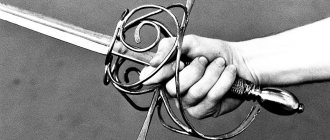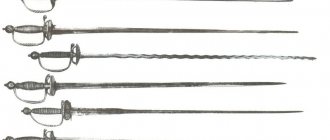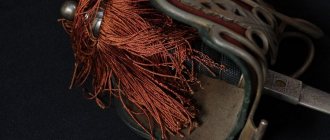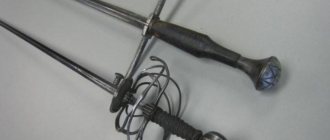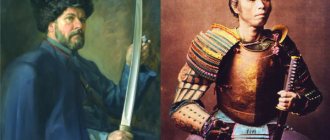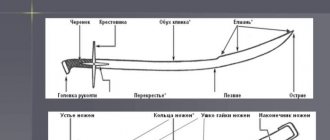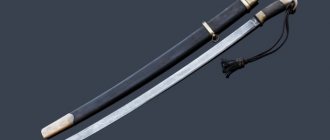At the beginning of the 16th century, France, and then other European countries, were gripped by “dueling fever,” which raged on the continent for more than three centuries. In just a few decades of the reign of the French king Henry IV, duels led to the death of approximately ten thousand people, most of whom belonged to the noble class. The main weapon in duels of that time was the sword.
Sword. This word itself is shrouded in a romantic aura. Pronouncing it, it’s as if you are transported to the narrow streets of Paris or Seville into the world of arrogant and hot-tempered hidalgos and musketeers, so masterfully described in the brilliant books of Dumas and Arturo Perez-Reverte. Without a doubt, the sword is the most “noble” edged weapon, the defender of noble honor and the most faithful friend of the brethren.
It is believed that the sword appeared around the middle of the 15th century in Spain. Very quickly it became popular not only in the army, but also as a civilian weapon for nobles or simply wealthy people. Over time, the sword turned into an indispensable attribute of any man from the noble class, and fencing with swords became the favorite pastime of the nobles. It is not without reason that in various European countries (including Russia) there was a custom of the so-called civil execution, during which the condemned man’s sword was broken over his head.
It was the sword that made a huge contribution to the development of fencing. Since dueling with swords was common, men learned to use these weapons from a young age. Fencing lessons were common, taken by men of all ages. In Europe there was even a very specific institution - fencing fraternities. These associations of professional fencers had an extensive network of branches, experienced instructors and a special examination system.
Today, epee fencing is an Olympic sport, although it must be recognized that sports epee combat is very different from the fencing matches of the past. The same can be said about the design of a sports sword, which has little in common with the blades of musketeers.
The rapier is considered a further development of the sword. Translated from Spanish, espada ropera literally means "dress sword", that is, a weapon carried with a civilian suit. In other words, the rapier was an exclusively civilian weapon, intended primarily for stabbing. Sort of like a light version of a sword. In Russia, a rapier is often called a weapon with a faceted blade, intended for training matches. However, the main difference between a sword and a rapier is that the latter has never been a military weapon.
It must be said that there is a lot of confusion on this issue. In historical sources, the same weapon can be called both a sword and a rapier. A similar situation is also observed in popular literature (for example, in “The Three Musketeers”). Of course, the most common opinion is that a sword was a weapon that could be used to chop an enemy, and a rapier could only be used to inflict injections. But, probably, contemporaries did not go into such subtleties too much, so initially these names were synonyms, which subsequently led to noticeable confusion.
Description
A sword is a bladed piercing or piercing-cutting weapon with a narrow, straight, double-edged, single-edged or faceted blade and a complex guard. On average, the length of the blade was one meter, but there were also larger specimens. Its cross-section could be hexagonal, triangular, oval, rhombic, concave. The weight of the weapon was usually about 1.5 kg.
The sword blade could have fullers or stiffeners. It ended with a shank on which the sword handle with bow and guard was mounted. Sword guards amaze with their elegance, complexity and variety; some of them had devices for capturing the enemy’s blade. Currently, this part of the sword is used to classify this weapon.
In essence, the combat sword was a somewhat lightweight sword with a narrow and flexible blade, designed more for thrusting than for cutting blows. It should also be added that in the design of this weapon much attention is paid to protecting the fencer’s hand. The evolution of the sword followed the path of its lightening and gradual transformation into an exclusively piercing weapon. In later swords, the blades could either be completely absent or not sharpened.
The classification of swords is based on the size of the weapon's blade, its weight, as well as the design features of the hilt. One of the most famous experts on European edged weapons, Ewart Oakeshott, divides swords into three large groups:
- Heavy combat swords (reitschwert - from German “horseman’s sword”), which could be used both for stabbing and chopping;
- A lighter sword (espada ropera - from Spanish “sword for clothes”), which had blades, but due to its low weight was not very suitable for slashing. This type of weapon was popular in the 16th century, later it was supplanted by even lighter swords;
- The third type of weapon, which received the English name small sword (“small sword”). Similar swords appeared in the middle of the 17th century and were distinguished by a light, faceted blade of short length.
Combat rapier
Having considered the question of how a sword differs from a rapier and a saber, a few words should be said about other types of historical weapons. Their main characteristics were finally determined at the end of the 15th century. The historical foil differs significantly from modern fencing equipment.
Translated, rapier literally means “sword for clothing.” This is a lightweight, practical weapon. In ancient times, it was worn not by the military, but by wealthy citizens of Spain. It does not cut as hard as a sword. However, her blades are sharpened.
It was a very popular weapon in the 15th-16th centuries. Later, rapiers were replaced by short swords. The latter were lightweight, but were more effective in battle.
The product, which was historically called a rapier, had a length of about 1.3 m. Its blade reached a length of about 1 m. There were many varieties of weapons presented. Historical fighting blades weighed more than modern sports equipment.
History of the sword
The sword is a further historical development of the sword. This statement does not mean at all that it is a better weapon than the good old sword, just that at the time of its appearance it was more suitable for the changed conditions of warfare. On medieval battlefields the sword would have been useless, but already in the Renaissance it proved to be a very effective combat tool.
The sword can be called the same age as a firearm. Moreover, the birth of these weapons is associated with the widespread use of guns and artillery on European battlefields. Today there are several hypotheses regarding the reasons for the emergence of these weapons.
Some authors believe that the sword appeared in response to the further improvement of plate armor, which became practically invulnerable to slashing blows. They say that using a thin blade, it was possible to hit an enemy in heavy armor, delivering piercing blows to their joints. In theory, this may look nice, but in reality it seems almost impossible. The so-called Maximilian armor had a degree of protection not inferior to modern spacesuits for deep-sea diving. Hitting an enemy protected by such armor in a real fight is extremely problematic.
Another theory seems more plausible, according to which swords did not appear to pierce heavy armor, but because due to the advent of firearms, heavy armor gradually became a thing of the past. There was no point in carrying an incredible amount of iron on oneself if it could not protect the fighter from a flying bullet. The heavy swords of the late Middle Ages were precisely designed to pierce such armor; after the reduction of defensive weapons, they also became unnecessary. At this moment the sword began its triumphal march.
It should be said that the early heavy sword was not much different from the medieval sword; it was somewhat lighter and more elegant. Even additional protection for the swordsman's hand could be found on swords of an earlier period. True, fencing technique, sharpened for piercing blows, led to a change in the grip of the weapon. To make it more manageable, the index finger rested on top of the cross and needed additional protection. In addition, at the same time, plate metal gloves went out of use, which interfered with the normal use of firearms. So gradually the handle of the sword turned into that complex structure by which it can be unmistakably recognized among other bladed weapons.
It is believed that the first swords appeared in Spain around the middle of the 15th century. This weapon very quickly became popular among the noble class. Swords were lighter than swords, so they were more convenient for everyday wear. This weapon was richly decorated to emphasize the status of the owner, but at the same time it absolutely did not lose its fighting qualities. Already during this period there was a division into military and civilian swords. By the end of the 15th century, the last variety received its own name, espadas roperas, which passed into other languages and gave its own name to the new weapon - rapier.
By the way, in most European languages there is no term for “sword”. This weapon was (and is) called “sword”. In Spanish it is espada, in French it is épée, in English it is sword, and only the Germans gave the sword its own name - Degen. Moreover, in German Degen also means dagger, which gave some researchers reason to believe that it was the predecessor of the sword.
The sword gradually spread to all types of troops, finally replacing the sword. The 18th century can be called the heyday of these weapons, then they gradually began to be forced out of the army by broadswords and sabers.
Civilian swords were lighter and narrower than military weapons; often only their tip was sharpened. At the end of the 17th century in France, a short civilian sword came into use, which, due to its light weight, made it possible to carry out masterly movements with the blade. This is how the French school of fencing appeared. At this time, the rapier and sword become practically indistinguishable from each other and completely lose their chopping function. The decrease in the mass of the sword occurred not only due to a decrease in its length and width, but also due to the fact that the blade became faceted. This is how a light civilian sword appeared, which survived until the beginning of the 20th century without much change.
The most popular were three-edged blades, although there were also examples with six edges. Initially, the blades were made wide at the hilt; it is believed that this part of the sword was intended to parry enemy blows. The classic narrow shape of the sword finally acquired by the era of the Napoleonic wars. We can say that from this moment the evolution of the sword ended.
It should also be said that the light civilian sword became the prototype of the modern sports rapier, and the basic techniques of sports fencing are based on the techniques of the French school.
The civilian sword was an extremely popular weapon. It was worn by nobles, bourgeois, military men in peacetime and even students. Wearing a sword was a privilege for them; students usually received swords after graduation, but there were exceptions. For example, students at Moscow University received the right to carry these weapons after entering the university.
German students not only enjoyed wearing swords, but also loved to use them in duels. Moreover, young men in Prussia were extremely proud of the scars they received in such battles. Sometimes they were specially rubbed with gunpowder so that the mark would remain for life.
In Russia, they tried to equip more rifle units with swords, but this weapon did not catch on. Later they began to use it en masse in units of the new system, and Peter the Great armed all Russian infantry with swords. But then the sword was replaced by a half-saber among the rank and file. The sword was left only to the officer corps and guards musketeers. In their design, Russian swords were no different from their foreign counterparts.
In the 19th century, swords in the Russian army lost their importance as military weapons and were gradually replaced by sabers. However, officers continue to carry them outside of formation, as a ceremonial weapon. Until 1917, the sword was the weapon of generals and officers of cuirassier regiments outside the ranks, in addition, it was worn by civil officials as an element of ceremonial clothing.
Comparative characteristics
Swords and rapiers have a rich history of development and have not lost their relevance today. The differences between these two weapons are as follows:
| Characteristics | Swords | Rapiers |
| Weight, g | From 770 | 500 |
| Length, cm | 110 | From 90 |
| Blade section | Triangular | tetrahedral |
| Guard diameter, cm | 13,5 | 12 |
| Tip | Equipped with a special sensor that triggers when pressure exceeds 550 g | Equipped with a movable electrical contact sensor |
| Injection | Apply to any part of the body, with the exception of the back of the head | Apply only to the jacket |
| Priority of actions | No | Eat |
Rapiers differ in that the straight handle can be replaced with a figured version.
There really is a difference between swords and rapiers, although outwardly these types of bladed weapons are very similar. The design of the models has undergone major changes more than once. Improved versions have survived to this day, which are actively used in the art of fencing.
Rapier and sword differ in the length and width of the blade
Rapier sometimes allows you to replace a straight handle with a figured one
The most common modern point of view is that the sword is a bladed weapon that allows you to both stab and chop the enemy, and the rapier can only stab
Fencing
The appearance of the sword gave a powerful impetus to the development of fencing. It cannot be said that before this they used swords to cut as best they could, but it was the lightness of the sword that made it possible to significantly expand the arsenal of fencing techniques. Very quickly, recognized fencing schools appeared: Italian, Spanish, French, German. Each of them had its own characteristics.
The Germans, for example, paid a lot of attention to slashing blows, and as an auxiliary weapon they used a heavy pistol, the handle of which struck like a club.
In the Italian school of fencing, for the first time, they emphasized piercing blows with the tip. It was in Italy that the principle of “killing with the point, not the blade” was born. A special dagger, the daga, was often used as an additional weapon in a fight. By the way, it is believed that duels appeared in Italy, replacing medieval knightly tournaments and duels.
The French school of fencing gave birth to a light short sword and gave the world the basic techniques for handling it. It is this that underlies modern sports fencing.
In England, during fights they often used a special shield-knuckles or daga.
The Spanish school of fencing was called Destreza, which can be translated as “true art” or “skill.” It taught not only how to fight with swords, but also how to use items such as a cloak, a daga, and a small shield in battle. The Spaniards paid attention not only to the skills of handling weapons, but also to the moral development of the fighter and the philosophical aspects of the art of war.
Is the sport of fencing that exists today similar to real sword fighting? There is an interesting statement that if a modern master of sports fencing went back in time, he could easily cope with any sword master of the Renaissance. Is it so?
The most important technical technique of modern athletes is the lunge attack, which is almost completely absent in ancient Italian and Spanish fencing schools. However, would it be useful in a real fight?
A lunge attack forces the fencer to stretch his stance. In this position, he is static, and it is difficult for him to defend against enemy attacks. In sports fencing, after the injection is carried out, the match is stopped, which, of course, is impossible in a real fight. At the same time, a single injection absolutely does not guarantee victory over the enemy. In sports fencing there are practically no defenses; fights are held according to the principle “whoever hits first gets the point.” In a real fight, it is simply necessary to defend yourself, because a missed injection does not mean the loss of a point, but injury, or even death.
Moreover, in the arsenal of historical fencing schools there were not only defenses with the blade, but also body movements: sharp rebounds, departures from the line of attack, sudden changes in level. In modern fencing, moving away from the line of attack is completely prohibited.
Now let's look at the weapons used by modern athletes and compare them with the swords of old times. A modern sports sword is a flexible steel rod weighing 700-750 grams; the main task of this weapon in battle is to lightly touch the opponent’s body. The swords of the old masters could weigh up to 1.5 kg; with this weapon it was possible not only to stab, but also to chop, depriving the enemy, for example, of his hands.
Even the fencing stances described in ancient manuals are the opposite of modern ones.
There is another myth, it is associated with the contrast between European and Eastern fencing techniques. They say that the Japanese are real virtuosos in the use of edged weapons, and the Europeans defeated their rivals in fights only due to physical strength and endurance.
This is not entirely true. The development of Japanese fencing can be divided into two large stages: before the onset of the Edo era and after it. The early periods of the history of the Land of the Rising Sun are remembered for almost continuous internecine wars, in which warriors fought on the battlefield using long tati swords and heavy armor. The fencing technique was very simple and consistent with that used in medieval Europe.
After the onset of the Edo era, the situation changed dramatically. Heavy armor and long swords are abandoned. The katana becomes a new mass weapon, which leads to the emergence of a new fencing technique, complex and sophisticated. Here we can draw direct analogies with Europe, where similar processes took place: the heavy combat sword was replaced by the sword. It was the appearance of these weapons that led to the emergence of very complex fencing schools, such as the Spanish Destreza, for example. Judging by the written sources that have come down to us, European fencing systems were not much inferior to Eastern ones. Although, of course, they had their own characteristics.

